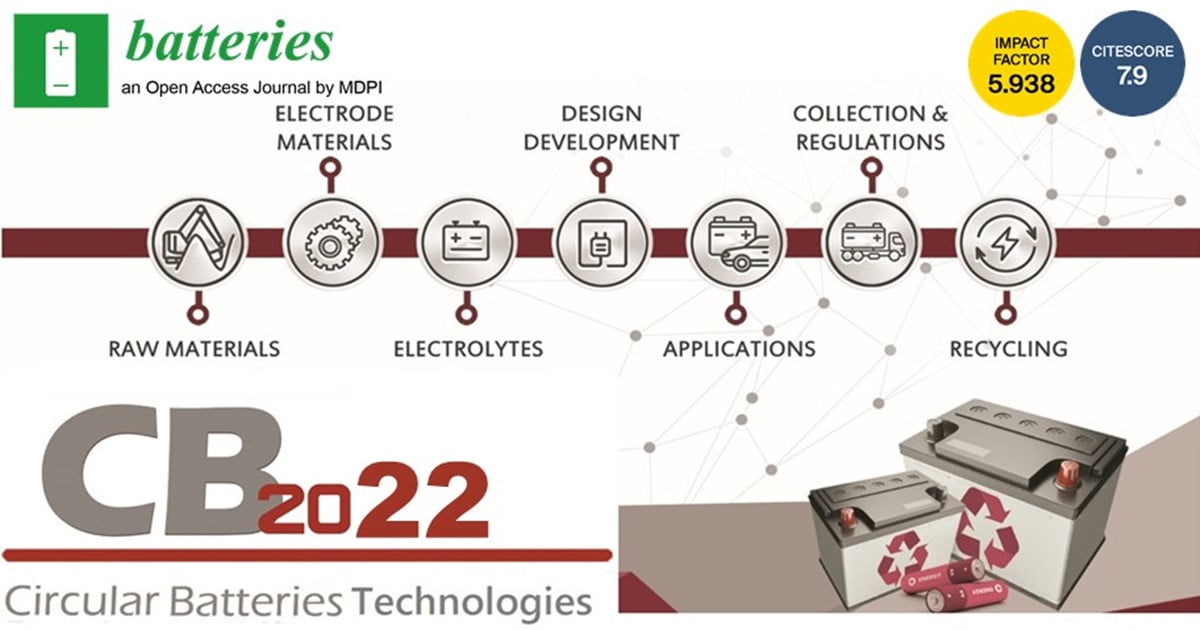- 4.8Impact Factor
- 6.6CiteScore
- 19 daysTime to First Decision
Circular Battery Technologies
Special Issue Information
Dear Colleagues,
The supply and management of energy are at the center of our daily concerns and represent a socio-economic priority. The increasing concern on global warming enforces the states and companies to concentrate on renewable energy sources to reduce the carbon footprint of energy production/consumption. The energy storage technology is the key player in this rapid change “modern time revolution”. Battery systems should store surplus electricity from the smart grid for hours, days, and even weeks, if necessary, because electricity generation from renewable sources fluctuates with weather conditions, Likewise, the replacement of internal combustion cars by electric vehicles to reduce the carbon dioxide emissions and to limit our dependence towards fossil fuels stimulate the search for energy storage devices including batteries, fuel cells, electrolysis for hydrogen production, pumped-storage power plants, etc. Thus the energy storage devices have been attracting enormous attention due to not only developments in the electronics industry, but also entering the electric vehicles to the market and the necessity of effective renewable energy applications.
Many electrochemical storage technologies have been developed since the first lead-acid battery invented in 1859 by Gaston Planté. Over the last two decades, the rapid progress in battery technologies has directly affected modern life, not only through various applications, but also with energy and carbon footprints of their production and manufacturing, from mining to end-of-life product management. Each technology finds its place depending on its applications. For instance, alkaline batteries are largely used for small home electronics because this technology is economical and safe. After the marketing of Li-ion batteries, the technology had been slowly dominated the most of battery applications from small electronics to vehicle technology and to stationary energy storage fields. Although battery technologies are mature, there are still many challenges to be faced in the development of performance, safe and sustainable technologies for dedicated applications. Increasing demand to the batteries triggered significant new problems, which are organizing sustainable raw material supply and how we will handle increasing battery waste amounts. A good balance must be found between battery performance, safety and recycling ability, as well as reliable raw material supply.
The following topics will be addressed in the Special Issue: Raw materials for battery technologies, electrolytes, electrode materials, design and development, applications (stationary batteries, electrified transportation, and smart grids), collection and regulation, secondary life and recycling.
Therefore, this Special Issue will gather, for the second time, contributions from several different communities: Electrochemistry, battery manufacturers, material science, engineering processes, extractive metallurgy, recycling, and Life Cycle Assessment.
Dr. Burcak Ebin
Dr. Martina Petranikova
Guest Editors
Manuscript Submission Information
Manuscripts should be submitted online at www.mdpi.com by registering and logging in to this website. Once you are registered, click here to go to the submission form. Manuscripts can be submitted until the deadline. All submissions that pass pre-check are peer-reviewed. Accepted papers will be published continuously in the journal (as soon as accepted) and will be listed together on the special issue website. Research articles, review articles as well as short communications are invited. For planned papers, a title and short abstract (about 250 words) can be sent to the Editorial Office for assessment.
Submitted manuscripts should not have been published previously, nor be under consideration for publication elsewhere (except conference proceedings papers). All manuscripts are thoroughly refereed through a single-blind peer-review process. A guide for authors and other relevant information for submission of manuscripts is available on the Instructions for Authors page. Batteries is an international peer-reviewed open access monthly journal published by MDPI.
Please visit the Instructions for Authors page before submitting a manuscript. The Article Processing Charge (APC) for publication in this open access journal is 2700 CHF (Swiss Francs). Submitted papers should be well formatted and use good English. Authors may use MDPI's English editing service prior to publication or during author revisions.
Keywords
- Electrochemistry
- Electrode materials
- Electrolyte
- Battery design
- Battery manufacturing
- Spent battery collection
- Secondary life - reuse Extractive metallurgy
- Recycling
- Life Cycle Assessment

Benefits of Publishing in a Special Issue
- Ease of navigation: Grouping papers by topic helps scholars navigate broad scope journals more efficiently.
- Greater discoverability: Special Issues support the reach and impact of scientific research. Articles in Special Issues are more discoverable and cited more frequently.
- Expansion of research network: Special Issues facilitate connections among authors, fostering scientific collaborations.
- External promotion: Articles in Special Issues are often promoted through the journal's social media, increasing their visibility.
- e-Book format: Special Issues with more than 10 articles can be published as dedicated e-books, ensuring wide and rapid dissemination.

